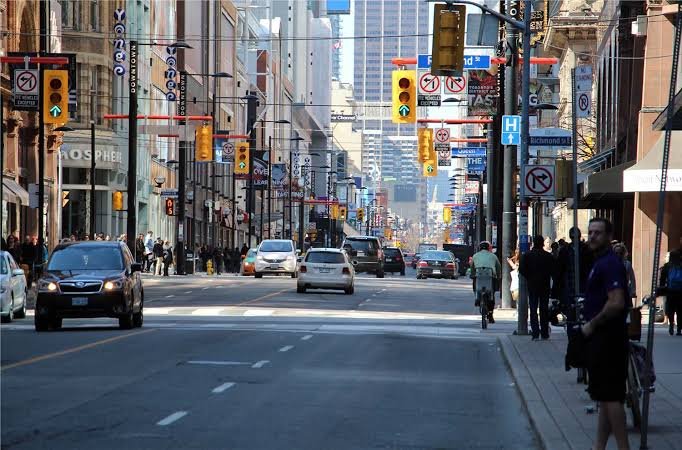Photo credit: Ilan Kelman
Did you know Yonge Street is the longest street in the world?
The street is in Ontario, Canada. It runs 86 km from the shores of Lake Ontario in Toronto to Lake Simcoe, a gateway to the Upper Great Lakes.
However, today, Yonge Street’s reputation as the longest street in the world is not the topic of discussion.
Instead, it is a finding that a two-kilometre strip of the street has the highest life expectancy in Toronto.
The Local reports that at the edge of Toronto, where the northeastern terminus of Line 1 bridges the gap between Toronto and the rest of the GTA, there is a long, skinny neighbourhood stretching from Finch Street to Sheppard Avenue. This narrow stretch of Yonge Street is lined almost exclusively with imposing condo buildings, erasing any notion of low housing density in the suburbs.
At street level, many businesses line the sidewalks, providing endless options for the ample foot traffic. Many of these businesses cater to the immigrant population that lives in the neighbourhood. There are Korean bars singing soju and tteokbokki, bubble tea shops with cutesy mascots smiling in the windows, and Iranian restaurants serving Persian classics, all of which tempt passersby with sprawling patios that spill onto the wide sidewalk.
This is Yonge-Doris, where residents live the longest in Toronto. An analysis by The Local, in collaboration with MAP Centre for Urban Health Solutions at St. Michael Hospitals, revealed that life expectancy at birth in Yonge-Doris is an impressive 86.2 years. It is well above the city average of 80.9 and almost a dozen years more than Moss Park, where the average resident lives to just 74.8. If the two-kilometre strip were a country, it would have the highest life expectancy in the world, just slightly above Japan.
Yonge-Doris was only established as its own neighbourhood in 2022; it is a little anomaly in the community.
Dr Andrew Pinto, a physician and scientist at the University of Toronto and the director of the Upstream Lab at University Health Toronto, said, “It’s always hard to attribute a phenomenon (like a high life expectancy) to any one specific thing. Income, immigration status, transit and walkability, access to services, housing conditions, …there are a lot of factors that come into play.”
According to 2021 census data, 64 per cent of Yonge-Doris’ residents are immigrants. Toronto has 47 per cent immigrants. Most of them are economic immigrants, that is, immigrants selected for their ability to contribute to Canada’s economy.
That demographic composition might explain Yonge-Doris’ high life expectancy by pointing to a phenomenon called the “healthy immigrant effect.” For the first ten or so years after someone moves to Canada, particularly in adulthood, their health tends to be better than that of someone born in Canada. There are a lot of theories concerning this. Still, Pinto pointed to Canada’s rigorous points-based immigration process that “selects for people with sufficient income, professional credentials, existing resources and so on.” The factors the government assigns high points, from education to wealth to professional accomplishments, are also indicators of good health.
However, the effect is temporary. After about ten years in Canada, immigrant health tends to decline and resembles that of the Canadian population, or even worse. Pinto explained that it “could be because of linguistic barriers accessing health care, challenges with the job market, and things like systematic racism that they face, for example, not having their credentials recognized to maintain a higher income.”
In Yonge-Doris, 23 per cent of residents are new immigrants who arrived between 2011 and 2021—almost double the city-wide average.
Related to the healthy immigrant effect is the “salmon effect.” Like salmon, many immigrants return to their place of origin as they age and their health declines. This drives up the relative proportion of healthy immigrants, explained Yasmin Aboelzahab, a PhD student at the Leslie Dan Faculty of the University of Toronto who studies how pharmacists can support newcomers and international students as they transition to the Canadian healthcare system.
The neighbourhood’s diversity could also be another key to its healthiness. In Yonge-Doris, 81 per cent of residents are of a visible minority, compared to Toronto’s 56 per cent. Most of the immigrants come from China, Iran or South Korea. Newcomers from India and other Asian places are increasingly calling the place home.
Several resources are dedicated to newcomers, such as ESL schools, newcomer centres, and public library services. Other immigrants are also invaluable resources for newcomers. Moving somewhere where there are people from your cultural background can ease the transition to a new country.







